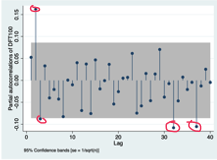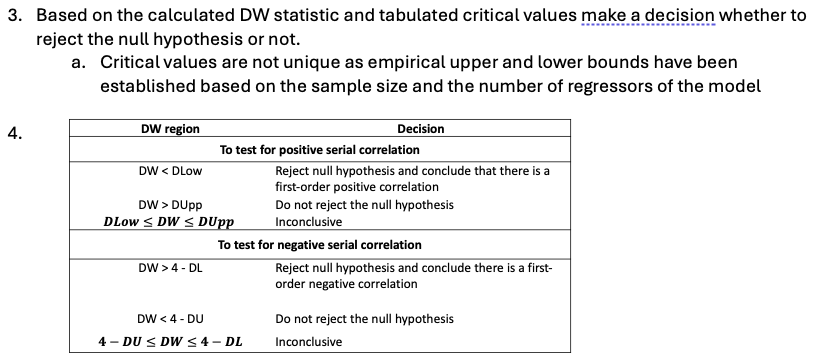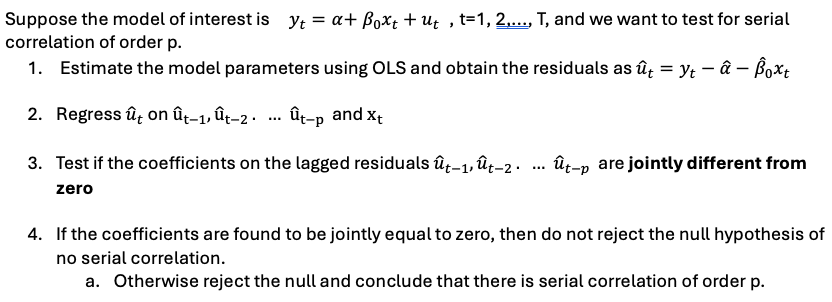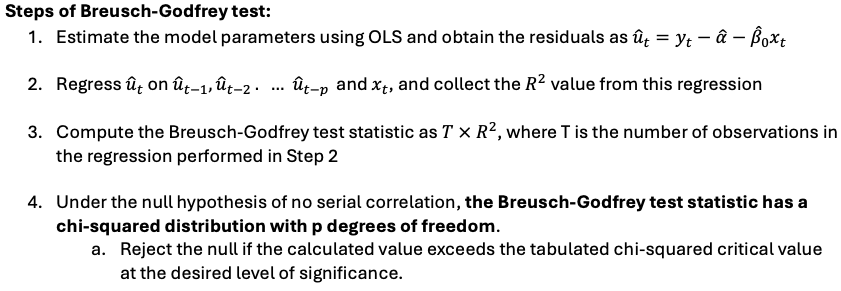Applied econometrics 2 lectures 1-4 - Time series regression
1/46
Earn XP
Description and Tags
Name | Mastery | Learn | Test | Matching | Spaced |
|---|
No study sessions yet.
47 Terms
Time series data
consist of observations on a given economic unit (e.g. a country, a stock market, a currency, and an industry) at several points in time with a natural ordering according to time
Frequency
The length between two successive observations
high vs low frequency
The more high frequency the data is, the more observations are taken. E.g. monthly is more high frequency to yearly
The signal
The systematically predictable component of the time series
What does the signal consist of
The signal consists of three major components: trend, seasonal and cycle. A given time series may incorporate some or all of these components
The signal - trends
the persistent tendency (if any) of the time series to increase or decrease over time.
o Trends may change over time both in magnitude and direction
The signal - Seasonality
a type of cyclicality where the time series has a tendency to increase or decrease in predictable or regular ways
o E.g. at the same quarter of year or the day of the week. This gives the time series a smoothly oscillating character.
o Often series that display seasonal patterns are seasonally adjusted before being reported for public use
The signal - cycles
When a time series oscillates around a trend
o The timing and duration of oscillations of cycles however can often tend to be irregular or aperiodic
Lagged variable
the observation in the previous period being used (t-1)
Difference variable
the difference between the current value of the variable and its value in period t-1
• With X measured in logs, the first difference would give the proportional (%) change in X between period t-1 and t
Stationarity
A variable that trends back to the same mean
if I look at different same-length “chunks” of the time series, they should look similar
Nonstationary
A variable that doesn’t tend to go back to the same mean
Stationarity in economics
In general, most macro and financial variable are nonstationary, but their first differences (or returns) tend to be stationary
Stochastic process / time series process
sequence of random variables indexed by time
(1st) Autocorrelation / serial correlation
Correlations involving a variable and its own (1st) lag

Autocorrelation function (ACF / correlogram)
gives a sequence of autocorrelations across different lag lengths / orders
• Autocorrelations measure the strength of linear association between two variables → Lies between -1 (perfectly negatively correlated) and 1 (perfectly positively correlated).

partial autocorrelation function (PACF)
the correlation conditional on all other autocorrelations in between - net correlation
PACF between Xt & Xt-3 includes order 1&2

Dynamic relationship
where a change in a given variable X today, has impact on that same variable or other variables in one or more future time periods
Static model
An explanatory variable x only has a contemporaneous impact on y
yt = f(xt) + ut
finite distributed lag (DL) model
A dependent variable y is a function of current and past values of an explanatory variable x but not its own past values
yt = f(xt, xt-1, xt-2, …) + ut
Lags of x impact y


autoregressive (AR) model
A model exclusively made up of lagged dependent variables as explanatory variables
yt = f(yt, yt-1, yt-2, …) + ut
a regression of y on its own lags

autoregressive distributed lags (ARDL) model
A combination of models DL and AR
yt = f(yt, yt-1, yt-2, … , xt, xt-1, xt-2, …) + ut
Y is impacted by its past self and current + past of other variables
If you include 1 lag of y and 2 lags of x you have the ARDL (1, 2) model

Effect of a temporary increase in x - DL model
Suppose xt increases to xt +1 temporarily


impact multiplier DL model
β0 – what happens to yt today if xt changes by 1 unit today
Lag distribution
All βj‘s as a function of j
Found when finding the difference between real and counterfactual for all future periods - summary of the dynamic effect on y of a temporary increase in x.
B0 impact today + B1 impact tomo + B2 impact 2 days from now…
Effect of a permanent increase in x - DL model
Suppose xt increases to xt +1 permanently

Long-run multiplier - DL model
β0 + β1 + … + βk
Weak dependence
As time passes correlation falls and eventually reaches 0
All AR(1) processes are weakly dependent if |p| < 1
Asymptotic properties of OLS
TS1 - Linear in parameters and weak dependence
TS2 - Zero conditional mean (only require contemporaneous not lagged variables)
TS3 - No perfect collinearity
+ To make asymptotically normal:
TS4 - Homoscedasticity
TS5 - No serial correlation
Possible failures of OS assumptions and solutions
Failure of: TS.4 → Use heteroskedasticity-robust standard errors
Failure of: TS.2
A possible violation could occur if both y and x are correlated with unobserved trending variables (spurious regression) → control for a time trend by adding t as a right- hand-side variable
Seasonality → use seasonal dummies
Failure TS5 - No serial correlation
Correlation of errors and nature of correlation
If corr(ut , ut-k ) ≠ 0 for at some k, → serial correlation

Causes of serial correlation in errors
• Variables omitted from the time-series regression that are correlated across periods and are now lumped into the error term.
• The use of incorrect functional form (e.g., a linear form when a nonlinear one should be used).
• Systematic errors in measurement
Consequences of serial correlation - Bias
If the model contains lagged dependent variables - OLS biased on all coefficients
if no lagged variables then no bias (but inefficient)
Consequences of serial correlation - Inference
Breaks TS5 → Standard error calculation incorrect → invalid hypothesis testing procedures (t test etc.)
True with or without lagged dependent variables
Tests for serial correlation
Durbin-Watson test
Only Tests for first order autocorrelation
Not Valid if model contains Lagged dependent variables
Durbins’s Alternative test
Can test for higher orders
Can be used if model has Lagged dependent variables
Breusch-Godfrey test
Same as Durbins alternative
Durbin-Watson test (not including how to carry out)

Can only be performed if regression model has an intercept + NO LDV + Autocorrelation of first order
Durbin-Watson test steps to carry out


Durbin’s Alternative test steps to carry out

Breusch-Godfrey test steps

Solutions to serial correlation
i. Fix the standard errors: Newey-West standard errors [Modern solution]
ii. Change the estimator: Feasible generalised least squares estimator [Old School]
Pros and cons of NW
Pro
Robust to arbitrary form of correlation
Cons
Need to specify no. lags
Might not be efficient
Does not fix bias from LDV
Pros and cons of FGLS
Pros
Most efficient estimator (if you get it right)
Cons
You need to correctly specify functional form of serial correlation
Newey west standard errors
If the model doesnt contain LDV, you can estimate the model parameters using OLS and then compute standard errors
The resulting standard errors are robust to heteroscedasticity and autocorrelation
Known as autocorrelation consistent (HAC) standard errors.
- HAC SEs allow for unrestricted serial correlation (up to the order of the chosen lag) and heteroskedasticity
- Major advantage: serial correlation can be of any form - no need to make a precise functional form assumption.
- Con: you need to specify the number of lags in the serial correlation.
Feasible Generalised least squares estimator (FGLS) steps
Assume a structure in the serial correlation
Quasi-difference your variables
Lag the original model by 1 period
Multiply lagged model by p + subtract from og model
rewrite model where (variable)* = og - lagged
The quasi-differenced model has a serially uncorrelated error (OLS works) but p is unknown
Estimate og model with OLS
regress error on lagged error for estimate of p and p^
use p^ to obtain initial FGLS estimate
Use residuals to redo step 5 + 6 until convergene in estimate of p
BG test steps
Estimate model
Obtain residuals
Regress ut on ut-1 , ut-2 … & xj
Get R2
BG test stat = T*R2
Chi squared with p Df
Null no serialcorrelation
DA test steps
Estimate model
Obtain residuals
Regress ut on ut-1 , ut-2 … & xj
Obtain coefficients
Test for joint significance of coefficients
If = 0 then don’t reject null of NO serial correlation